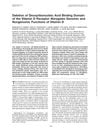Hereditary 1,25-Dihydroxyvitamin D-Resistant Rickets Due to an Opal Mutation Causing Premature Termination of the Vitamin D Receptor
February 1998
in “
Journal of bone and mineral research
”
TLDR A specific gene mutation causes vitamin D-resistant rickets and hair loss.
The study investigated a young French-Canadian boy with hereditary vitamin D-resistant rickets (HVDRR) and total alopecia, identifying a unique C to T mutation in the vitamin D receptor (VDR) gene. This mutation resulted in a premature stop codon at amino acid 30, truncating the VDR and causing resistance to 1,25-dihydroxyvitamin D3. The patient's fibroblasts showed very low VDR protein levels and failed to induce gene transcription in response to 1,25(OH)2D3. The parents were found to be heterozygous for the mutation. The Arg30stop mutation was concluded to be the molecular basis of HVDRR in this patient.

